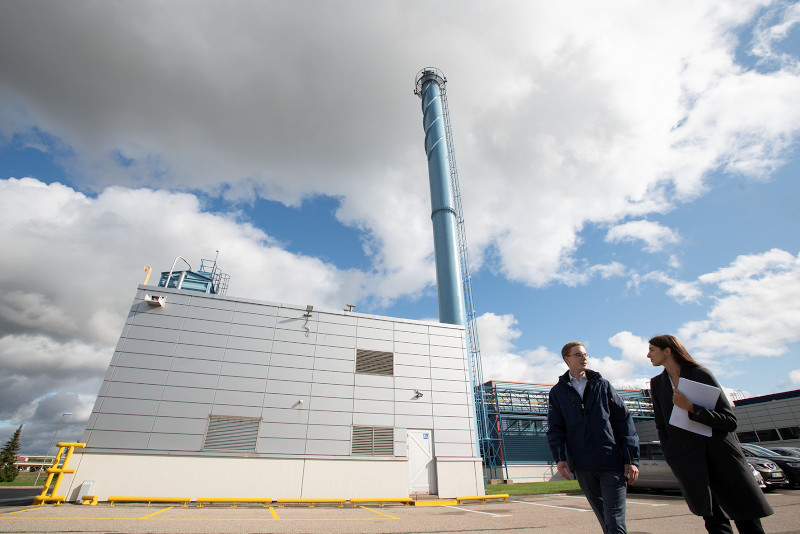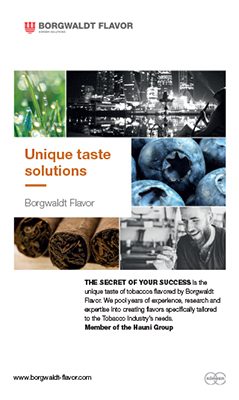Going Greener
- Also in TR Sustainability
- March 31, 2020
- 0
- 0
- 13 minutes read


Cigarette companies step up efforts to reduce their environmental footprint.
By Stefanie Rossel
While the health implications of combustible cigarettes have been in the spotlight since the U.S. Surgeon General in 1964 published his first report on smoking and health, the environmental impact of tobacco manufacturing has only recently become the subject of scientific research and greater public awareness.
Tobacco cultivation requires scarce arable land and significant amounts of water in often water-stressed areas. In addition, leaf production involves the use of harmful pesticides and herbicides. For curing, farmers often use wood, which leads to deforestation. Tobacco cultivation is responsible for the majority of carbon emissions in the entire manufacturing process, followed by the supply of nontobacco materials for cigarette production and distribution/logistics.
Cigarette manufacturing is energy intensive, with most energy still coming from nonrenewable sources. It is a process that creates—partly toxic—waste and emissions due to chemical additives and nondegradable cellulose acetate filters and packaging, among other things. The rise of next-generation products (NGPs), which often include sophisticated electronics, has added an additional environmental challenge.
In the past five years, a number of studies have looked at tobacco’s effect on the environment, among them a report by the World Health Organization (WHO), “Tobacco and Its Environmental Impact: an Overview From 2017.” A WHO-backed study by Imperial College London from 2018, “Cigarette Smoking: an Assessment of Tobacco’s Global Environmental Footprint Across Its Entire Supply Chain,” came to the sobering conclusion that a smoker consuming one pack of combustible cigarettes a day over 50 years had a carbon footprint of 5.1 tons. To offset this impact would require 132 tree seedlings growing for 10 years. The same smoker’s water footprint (1,355 m3) would supply three people’s basic food and hygiene needs for almost 62 years. His fossil fuel depletion during that time equals 1.3 tons of oil consumption, which compares to the electricity use of an average Indian household for almost 15 years.
To calculate the environmental impact of the global tobacco supply chain, the researchers developed a global cigarette production and conceptual model. Annually, around 6 trillion cigarettes are consumed worldwide. According to the Imperial College study, their production brings about a CO2 equivalent emission of 84 million tons per year, thus contributing 0.2 percent of global total greenhouse gas emissions to climate change. It involves 22,200 million tons of water, the use of 5.3 million hectares of land, 62.2 gigajoules of energy, and 27.2 million tons of material resources annually while creating 25 million tons of solid waste and 55 million tons of wastewater. With almost 90 percent of leaf production and the majority of cigarette consumption now concentrated in lower-income and middle-income countries, the report argues, the environmental burden and risks associated with tobacco are carried mostly by developing countries.
Focus on minimizing
The tobacco industry has not been idle on this problem, though. The leading manufacturers have been continuously reducing the environmental impact of their supply chains and released the results in their corporate sustainability reports (CSR). However, this has evoked new criticism: A 2018 Royal Swedish Academy of Sciences (RSAS) report looking at the environmental externalities of tobacco manufacturing argued that the reports were nether systematic nor standardized (which is true for sustainability reporting in other industries as well), nor were they independently verified. As a result, the RSAS authors claimed, cigarette companies’ self-reported sustainability goals remained vague, fragmentary and opaque, with achievements being measured against self-set baselines or by omitting or including different areas of reporting over time. The study also argued that tobacco companies prioritized ecological modernization of their manufacturing facilities predominantly in countries where they are obliged to by environmental regulations, whereas in countries with few environmental protections, their plants had not been updated accordingly.
This may change, however, with the inclusion of the WHO Framework Convention in Tobacco Control in the United Nations Sustainable Developments Goals, according to the RSAS study. When talking to cigarette companies, it appears that this transformation has already started. Sustainability has featured prominently on the agendas of the world’s two leading international tobacco companies, British American Tobacco (BAT) and Philip Morris International (PMI).
“While our management systems address a wide range of environmental issues, we have a specific focus on managing our key issues of energy use, carbon emissions, waste management and water use,” a BAT spokesperson told Tobacco Reporter.
“We are making great progress against our targets to achieve a 30 percent absolute reduction in our direct emissions—referred to as Scope 1 and 2—and a 16 percent absolute reduction in Scope 3 supply chain emissions from purchase[d] goods and services, a 35 percent reduction in water withdrawn and reduced waste to landfill by 40 percent by 2030, against our 2017 baseline.
“With our agricultural supply chain, we aim to deliver a positive social impact wherever we operate. We strive for excellence in the management of our environmental footprint and we are constantly working on new and innovative sustainable farming technologies, techniques and best practices, which we roll out to farmers as part of our extensive agri-support packages. For example, by introducing new technology, such as tobacco seeds that can have increased resilience, integrated pest management, and more efficient uses of water, soil and wood fuel, which can reduce water and energy consumption and prevent soil loss,” the spokesperson said.
Carbon-neutral factories
PMI says its carbon-reduction strategy focuses on three areas: reducing emissions in manufacturing operations, lowering carbon emissions from transport and working with tobacco farmers to reduce emissions. In October, the company’s factory in Klaipeda, Lithuania, became PMI’s first plant to be carbon neutral. All others are supposed to be CO2 emission-free by 2030. “At our Klaipeda factory, we implemented multiple projects over the past 10 years to optimize its energy usage and reduce carbon emissions,” a PMI spokesperson explained. “This includes upgrading utilities equipment, such as chillers and compressors, and facilitating heat recovery to optimize fuel usage for heating purposes, installing a biomass boiler, procuring certified renewable electricity and offsetting natural gas carbon emissions with biogas certificates. We plan to take similar measures to achieve carbon neutrality at all of our factories, focusing on energy efficiency, eliminating losses and switching to renewable energy.”
To reduce emissions from manufacturing, PMI will continue to optimize energy efficiency, including switching to lower-carbon renewable energy sources and sourcing renewable electricity. To get the Lithuanian factory carbon neutral, the company also made use of CO2 compensation, including offsetting natural gas carbon emissions with biogas certificates. Carbon compensation is a controversial issue—opponents compare it to selling indulgences, whereas proponents say it’s better than nothing.
“Like many corporations, PMI could be carbon-neutral tomorrow if we just purchased carbon credits,” the company’s spokesperson pointed out. “But for us, this is the last step of our program, and our focus remains on efforts to address energy efficiency at each of our factories. Our ambition is not to purchase any carbon credits in the future—but to continue developing effective projects to improve the environmental footprint of our value chains. In the case of Klaipeda, only 1 percent of carbon emissions were offset by carbon compensation. This was done by investing in Gold Standard certificates from climate protection initiatives that support more than 9,000 families in India by promoting domestic biogas production to replace kerosene and firewood as cooking fuels.”
Greater focus on climate change
BAT’s efforts focus on the company’s factories, green-leaf threshing sites and large fleet, which is used mostly for distribution and marketing. Together, they account for more than 90 percent of the company’s direct carbon emissions, according to BAT. “This includes exploring energy-efficient technologies, switching to low-carbon or renewable energy sources, and optimizing our logistics and fleet with new standards for fuel efficiency,” said BAT’s spokesperson. “BAT operates in diverse locations around the world, where the availability of renewable energy, along with environmental legislation, infrastructure, environmental technologies and water scarcity can vary significantly. “Our approach is therefore to understand our impact in these environments and put plans in place to minimize it.”
In its capital markets update in late March, BAT announced stretching new targets across the environmental, social and governance (ESG) landscape. “Our ambition is […] to achieve carbon neutrality by 2030, while bringing forward our existing 2030 environmental targets to 2025. The importance of this agenda, and communicating our progress against it, is reflected in our new organizational structure, with the ESG and communications functions now reporting to Kingsley Wheaton, chief marketing officer,” the company said.
For PMI, reducing its environmental footprint is a global goal, the company’s spokesperson explained. “We prioritize carbon reduction projects in our factories around the world based on their CO2 emissions, not only on the local regulatory context. […] Overall, more and more of our factories buy electricity from renewable sources, representing more than 65 percent of our consumption globally. We recognize that the carbon-neutral solutions we develop need to be compatible with different policy frameworks, cultures and even geographical climates. To that end, our central sustainability function has identified a portfolio of possible energy efficiency initiatives and is assessing them on a location-by-location basis to see which make sense for each factory and what results they are likely to deliver in context. The same process will be undertaken for decisions around procuring renewable electricity, as we strive to source 100 percent of our energy for factories from renewables by 2030.”
Compensating for NGP production
Efficient water management is also on PMI’s agenda. The company has implemented the Alliance for Water Stewardship (AWS) standard in six of its factories. “Five more will be certified this year as we continue toward our goal of having all factories AWS-certified by 2025,” the spokesperson said. “AWS is about much more than just reducing how much water we use; it’s about ensuring that our use of water is sustainable, within the local watershed and taking into account the needs of local stakeholders. In March 2018, our factory in Brazil became the first in Latin America to gain the AWS certification. The increase in awareness of water issues within the site along with the implementation of the technical mitigation activities implemented by the AWS plan include the reduction of water use of 8 percent in 2019, 12 percent in 2020, 12 percent in 2021 and 8 percent in 2022.”
With its IQOS heated tobacco product (THP), PMI is the world’s leading manufacturer in this product category. The company, which has set itself the ambitious goal to make the world smoke-free, also markets a range of e-cigarettes. Both THPs and e-cigarettes comprise electronic components that are usually purchased from third-party providers in China. Under the Greenhouse Gas Protocol Standard, the emissions caused by these suppliers qualify as scope 3 emissions, which are all indirect emissions that occur in the value chain of the reporting company. In the past, cigarette companies have been criticized for not including these emissions in their calculations. PMI says its updated carbon footprint model better prioritizes its actions and tracks its suppliers’ improvements to ensure that it has more accurate scope 3 figures. “We have included more primary data from our suppliers, an updated methodology and a better understanding on risks and opportunities to reduce carbon emissions. Furthermore, a full third-party verification brings extra credibility to the results.”
The transition in manufacture toward HTP increased PMI’s water usage per product unit across the company from 2017 to 2018. “More energy and water are required to manufacture heated tobacco units, as additional manufacturing steps are needed for smoke-free products compared to cigarettes,” the company’s spokesperson said.
“As we increase the production capacity for smoke-free products, we evolve our water strategy with clean technology investments delivering water recycling projects. For instance, in our factory in Italy, we implemented water recycling technology to compensate for the increase in water typically expected in the manufacture of smoke-free products. In 2018, 73,000 cubic meters of water could be recycled internally (13 percent of the total site water use), with a second step implemented in 2019. The technology that was developed will be implemented at other sites in the future.”


